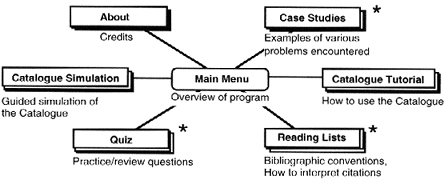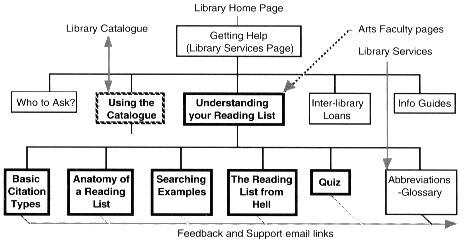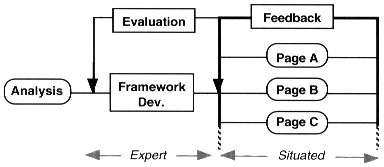
 |
Interactivity on the web has until recently been accomplished with HTML forms and CGI scripts, lacking the responsiveness of stand alone computer programs and consequently limiting the effectiveness of learning interactions. With the release of ShockWave, MacroMedia Director animations can now be incorporated directly into Web pages to provide high quality animation and interactivity, to support for example, tutorial style questions and instantaneous feedback. This paper looks at the application of this technique in the translation of a 'traditional' computer based tutorial into an online version. Further, a simple authoring front end to these interactive elements makes it possible to capitalise on the Web's modularity and potential for efficient development and implementation. It is apparent that changes in roles and responsibilities of all participants can result from this approach.
The tutorial, 'Ariadne's Thread', was originally designed to reduce the load on Library staff and lecturers by increasing the library skills of first year Arts students (Jones & Fritze, 1996). It was developed in HyperCard by the Interactive Multimedia Learning Unit of the University in conjunction with University librarians and lecturers from the Faculty of Arts. The main areas of focus were use of the catalogue system and interpretation of reading list citations. Each topic area in figure 1 consists of several screens employing a combination of information and interactive questions. A mythological metaphor supported the navigational structure of the program, providing a 'thread', hopefully not mythical, to assist students in making their way through the 'maze' of the Library. The program was developed and trialed during 1994 and scheduled computer laboratory sessions organised by library staff were first offered to students on a voluntary basis in 1995.

Figure 1: Topic structure of Ariadne's Thread (* topics translated to the Web version)

Figure 2: The Ariadne Collection pages (in bold)
While the operation of the question is defined in the ShockWave file itself, the content and feedback is specified in an external text file in the form of question script shown in table 1. This text based approach to authoring follows from protocol used extensively in producing computer based learning materials in Chemistry (Fritze, 1993). When the Web page is loaded, the ShockWave file retrieves the question script file 'Question.txt' across the network and interprets it to configure the question. Generating a web topic page therefore involves skills little more involved than word processing:

Figure 3: Structure of an Ariadne Collection page
|
SECTION_ 1. Understanding your Reading List
QUESTION_ Book Citation |
A major development component of Ariadne's Thread centred on navigational interface design, involving choice of metaphors, programming, user evaluation etc. This 'packaging', a common feature of many CFL programs, arguably has little direct impact on the educational purpose of the program. In contrast, the Web browser interface provides a standardised navigational framework. Multiple, re-sizeable and extended page views, with efficient scrolling, handles information more efficiently and without the painstaking design and chunking associated with the fixed 640 x 480 screen format. While the graphics in the original program was not extensive, some additional thought was required to optimise the Web file sizes.

Figure 4: Production cycle Ariadne's Thread.
Production of the Collection on the other hand, appeared to reflect the more modular nature of the materials with the activities separating into two distinct levels, 'expert' and 'situated' (figure 5).

Figure 5: Production cycle of the Collection.
Expert activities involved specialist professional and technical expertise in the design and programming of interactive element mechanisms, formats, network logging systems, templates for pages etc. Output of this activity provided a framework to facilitate the second level of development activities, situated far more within the context of implementation.
Situated activities involved content experts in the on-going process of writing, implementing, reflecting and refining materials. This could be considered an aspect of normal teaching practice.
In sixty timetabled computer laboratory sessions spread over 9 weeks in 1995, only 290, or 15% of the target group made use of Ariadne's Thread. Students attended more sessions early in the semester, the anecdotal evidence being that, at the time of actual need, pressure of studies made sessional attendance difficult. On the other hand, the Collection potentially can be accessed at any time by students from all courses and levels, staff members and even the public. Access could be from home or any of the computer laboratories around the University. There is a distinct change in the nature of the materials here - rather than providing a goal based training solution the observed problem, the Collection has the capability of providing on demand performance support for students. This support has the potential of linking directly from the Catalogue access page.
Moreover, content experts are now able to respond immediately to needs observed within the library or from feedback to the lecturers. It is anticipated that the Collection will continue to evolve in this manner, complementing other Web resources being developed concurrently. With the limitations imposed by the requirements for specialised software and lab based delivery are removed, it is expected that this responsibility may well extend to increasing numbers of content experts. While computer class sessions may still be organised for the following year, these are likely to include network skills and resources. It is intended that other forms of online support will be incorporated, for example email link to enable students to post queries directly to an electronic help desk with responses summarised on a Web page.
In this more 'democratic' environment, questions of ownership and responsibility have arisen which will need to be addressed, for example:
Should the Arts Faculty continue to fund such developments if significant use of the materials is made by 'outsiders'?How will on going refinement of materials or hotline support be accommodated into existing budgets and infrastructures?
While the prospect of a publishing a saleable product existed for the original project, what commercial potential does the Collection have?
Will pages of the Collection be identified as such to the user?
Jones, D. & Fritze, P. (1996). Ariadne's Thread: An interactive computer assisted training program teaching undergraduates how to maximise their use of the Library OPAC and how to understand the basics of bibliography. pp. 477-484. Proceedings of the 1996 VALA Biennial Conference.
Fritze, P. A. (1994). A visual mapping approach to the evaluation of multimedia learning materials. pp. 273-285 in K. Beattie, C. McNaught & S. Wills (Eds), Interactive multimedia in university education: Designing for change in teaching and learning. Amsterdam: Elsevier.
| Author: Paul Fritze, Centre for the Study of Higher Education, The University of Melbourne. P.Fritze@cshe.unimelb.edu.au
Please cite as: Fritze, P. (1996). An implementation of interactive objects on the Web. In J. G. Hedberg, J. Steele and S. McNamara (Eds), Learning Technologies: Prospects and Pathways, 55-60. Selected papers from EdTech'96. Canberra: AJET Publications. http://www.aset.org.au/confs/edtech96/fritze.html |